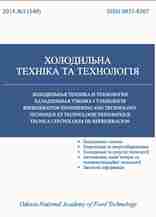EFFECT OF INORGANIC MATERIALS ON THE BEHAVIOR OF SUPERCRITICAL WATER NEAR PSEUDOSPINODAL
DOI:
https://doi.org/10.15673/0453-8307.3/2014.32569Keywords:
equation of state, supercritical water, Widome line, nuclear power plants of 4th generation, working fluidAbstract
Supercritical water is a promising working fluid in the new nuclear power plants of the 4th generation. Due to the presence of the pseudo-critical line, thermo-hydraulic as well as physical and chemical properties of supercritical water differ significantly from the pressurized hot water used in cooling loops of water reactors. The impact of small amount of inorganic substances addition to the thermal properties and hydraulics of the supercritical water utilized as working fluid for nuclear reactors cooling as well as nonnuclear supercritical water-cooling loops applications is analyzed in the paper.
References
REFERENCES
1.Schulenberg T. Three pass core design proposal for a high performance light water reactor / Schulenberg T., Starflinger J., Heinecke J. // Progress in Nuclear Energy. – 2008. – 50(2–6). – p.526–531.doi: 10.1016/j.pnucene.2007.11.038
2.Marsall W. Liquid–vapor critical temperatures of aqueous electrolyte solutions / Marsall W., Jones E. // J.Inorg.Nucl.Chem.–1974.–36(10).–p. 2313 – 2318.doi: 10.1016/0022-1902(74)80275-7
3.Marsall W.L. J. Critical curves of aqueous electrolytes related to ionization behaviour: new temperatures for sodium chloride solutions // Chem. Soc., Faraday Trans. – 1990. – 86. – PP.1807 – 1814.doi: 10.1039/ft9908601807
4.Thiery R.Explosivity Conditions of Aqueous Solutions / Thiery R., Mercury L. // J. Solution Chem. – 2009. – 38(7).– PP. 893–905.
5.Kritzer P. Corrosion in high–temperature and supercritical water and aqueous solutions: a review // J. Supercrit.Fluids. 2004. – 29(1–2). – PP. 1–29.doi: 10.1016/s0896-8446(03)00031-7
6.Wagner W. The IAPWS Formulation 1995 for the Thermodynamic Properties of Ordinary Water Substance for General and Scientific Use / Wagner W., Pruss A. // J. Phys. Chem. Ref. Data. – 2002.– 31(2).– PP. 387–535.doi: 10.1063/1.1461829
7.Driesner T.The system H2O–NaCl. Part II: Correlations for molar volume, enthalpy, and isobaric heat capacity from 0 to 1000 °C, 1 to 5000 bar, and 0 to 1 x NaCl // Geochimica et CosmochimicaActa. – 2007.– 71(20).– PP. 4902 – 4919.doi: 10.1016/j.gca.2007.05.026
8.Wang J. Investigation of forced convection heat transfer of supercritical pressure water in a vertically upward internally ribbed tube / Wang J. // Nucl. Eng. Design.–2009.–.239(10).– PP.1956–1964.doi: 10.1016/j.nucengdes.2009.04.012
9.Bernabei M. Percolation and clustering in supercritical aqueous fluids / Bernabei M., Ricci M.A. // Journal of Physics. Condensed Matter.– 2008.– 20.– PP. 494208 – 494210.doi: 10.1088/0953-8984/20/49/494208
Loewenberg M.F. Supercritical water heat transfer in vertical tubes: A look–up table / Loewenberg M.F. [таін.] // Progr. Nucl.Energ.– 2008. – 50(2–6). – PP. 532–538.doi: 10.1016/j.pnucene.2007.11.037
Házi G. On the Pressure Dependency of Physical Parameters in Case of Heat Transfer Problems of Supercritical Water / Házi G., Farkas I. J. // Eng. Gas Turbines Power. – 2009.– 131.– PP. 012904 – 012910.doi: 10.1115/1.2983135
12.Mukohara T. Core design of a high temperaturefast reactor cooled by supercritical water / Mukohara T, Koshizuka S.I., Oka Y. // Annals of Nuclear Energy. – 1999.– 26.– PP. 1423 – 1430.doi: 10.1016/s0306-4549(99)00032-8


